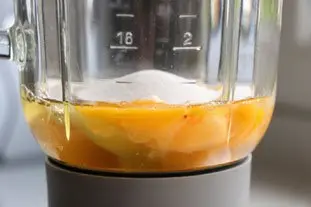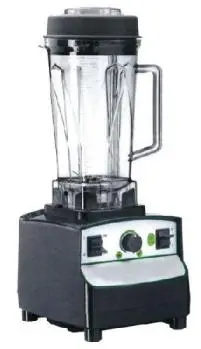This site uses only a few technical cookies necessary for its operation. By continuing to browse, you accept their use.
To find out more...
To find out more...
The right way to use a blender

You may well have a blender in your own kitchen. You know, that useful gadget that allows you to liquidize stuff at high speed into a smooth liquid. Of course, the most obvious use that comes to mind is for soups: if you have boiled some vegetables in water, with just a quick blast of the blender, you'll have a smooth, creamy soup.
24 K 5/5 (13 reviews)
Last modified on: May 31th 2017
The right way to use a blender
At this point, we really ought to distinguish between the 2 different types of blender: "stick" and "classic".
Stick blenders (the sort professional cooks sometimes call a "giraffe") are hand-held and are designed to be plunged directly into the bowl or pan when making soup, compotes, etc. They are usually simple machines and relatively cheap. They look like this:
The other type are a little more complicated and designed to stand on a worktop. The main difference is that the food is put into the blender's own bowl or goblet (glass or plastic). Then you need to put the lid on before switching the machine on. They look something like this:
Stick blenders are fairly self-explanatory. For the second type, there's one trick it's important to know.
When blending, there is often a mix of different textures – a liquid ingredient being mixed with a more solid one – even if the end result is more or less a liquid. When making homemade pesto, for example (which, it's worth saying in passing, is far superior to what you find in the shops), you will be blending liquid olive oil and lemon juice with solid pine nuts and basil leaves.
And this is where knowing the trick comes in: you should always put the liquid into the goblet first and only then add the solid ingredients. If you do it the other way round, your ingredients may well not mix together properly, with the liquid staying on top of the blended solids. You will be obliged to stop the blender several times to poke at it and stir with a spoon, or – even worse – you might be tempted to try and intervene with the blender still running, which is highly dangerous.
To see this in practice, here's a photo taken while making a flognarde (a sort of egg custard from France's Limousin region). One stage of the recipe involves blending the eggs with a mixture of flour and sugar:
You can see how the eggs (liquid) go in first, with the flour and sugar added on top. This ensures rapid and even mixing, as you can see here:
This goes for all blenders, even the most sophisticated ones that heat and cook, such as Thermomix.
To sum up: when blending different foods, always put the liquid ingredients into the blender goblet first, before adding the solid ones.
Stick blenders (the sort professional cooks sometimes call a "giraffe") are hand-held and are designed to be plunged directly into the bowl or pan when making soup, compotes, etc. They are usually simple machines and relatively cheap. They look like this:

The other type are a little more complicated and designed to stand on a worktop. The main difference is that the food is put into the blender's own bowl or goblet (glass or plastic). Then you need to put the lid on before switching the machine on. They look something like this:

Stick blenders are fairly self-explanatory. For the second type, there's one trick it's important to know.
When blending, there is often a mix of different textures – a liquid ingredient being mixed with a more solid one – even if the end result is more or less a liquid. When making homemade pesto, for example (which, it's worth saying in passing, is far superior to what you find in the shops), you will be blending liquid olive oil and lemon juice with solid pine nuts and basil leaves.
And this is where knowing the trick comes in: you should always put the liquid into the goblet first and only then add the solid ingredients. If you do it the other way round, your ingredients may well not mix together properly, with the liquid staying on top of the blended solids. You will be obliged to stop the blender several times to poke at it and stir with a spoon, or – even worse – you might be tempted to try and intervene with the blender still running, which is highly dangerous.
To see this in practice, here's a photo taken while making a flognarde (a sort of egg custard from France's Limousin region). One stage of the recipe involves blending the eggs with a mixture of flour and sugar:

You can see how the eggs (liquid) go in first, with the flour and sugar added on top. This ensures rapid and even mixing, as you can see here:

This goes for all blenders, even the most sophisticated ones that heat and cook, such as Thermomix.
To sum up: when blending different foods, always put the liquid ingredients into the blender goblet first, before adding the solid ones.
Lasts posts
Butter vs. grease
We often read in a recipe where a pastry is put into a mould that, just before pouring, the mould should be buttered or greased. But what's the difference between these 2 terms?December 1st 20251,2025
Getting out of the fridge early
Very often when you're cooking, you need to take food or preparations out of the fridge, to use them in the recipe in progress. There's nothing tricky about this: you just take them out of the fridge and use them, usually immediately, in the recipe. But is this really a good method?November 24th 20251,2085
Who's making the croissants?
When you look at a bakery from the outside, you naturally think that in the bakery, the bakers make the bread, and in the laboratory, the pastry chefs make the cakes. It's very often like that, with each of these professions having quite different ways of working, but sometimes there's also one...November 23th 20251,101
Oven height
When we put a dish or cake in the oven, we naturally tend to put it on the middle shelf, and that's what we usually do. But in some cases, this position and height can be a little tricky, so let's find out why.October 8th 20252,9975
The importance of sieving
In recipes that use a fine powder (flour, powdered sugar, etc.), you'll often see the advice to sift before using it. To sift is to pass the powder in question through a sieve (a very fine strainer) before incorporating it into your recipe. It's often advice, but is it really useful?September 3rd 20257,7013
Other pages you may also like
What is the difference between bakery and patisserie?
This is a question that you may well have asked yourself and which I will attempt to answer. In France the two trades of "boulangerie" (bakery) and "pâtisserie" (patisserie and confectionery) have always been quite distinct, but where exactly do the boundaries lie? .February 7th 2017134 K 14.1
Egg yolks and caster sugar
We often come across recipes where we need to mix egg yolks with caster sugar. This would appear to be a very ordinary and simple thing to do but, be warned, these two ingredients can behave oddly together.February 15th 201883 K 24.3
Candied fruits: don't get ripped off
Do you like candied fruit? You might like to nibble a handful or add it to a recipe, like a classic fruit cake or delicious Italian specialities like panettone or sicilian epiphany pie.June 21th 201767 K 24.2
A few tips for effective kneading at home
When you have to knead dough for bread or some other recipe, you may well use a food processor or the type of machine known as a stand mixer. The best-known brands are Kenwood and KitchenAid. They are useful tools, but here are a few tips to help you get the best out of them.June 23th 2021284 K 23.8
Chive flowers
Did you know that? Chive flowers are not only a beautiful purple color, but they are also edible and delicious.May 29th 201948 K4.4
Post a comment or question
Follow this page
If you are interested in this page, you can "follow" it, by entering your email address here. You will then receive a notification immediately each time the page is modified or a new comment is added. Please note that you will need to confirm this following.
Note: We'll never share your e-mail address with anyone else.
Alternatively: you can subscribe to the mailing list of cooling-ez.com , you will receive a e-mail for each new recipe published on the site.









